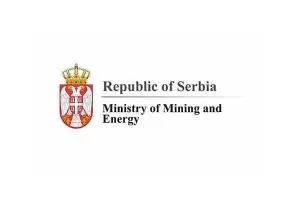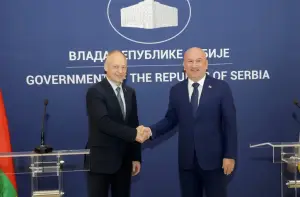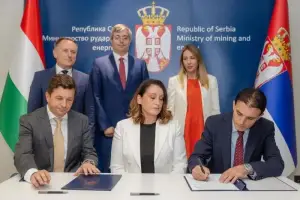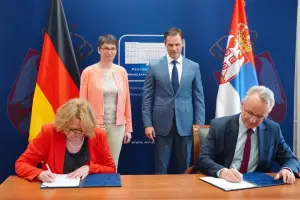Q:
A:
Foreign trade continues to grow
Belgrade,
28 December 2006
The Serbian Statistics Office stated today that Serbia's overall foreign trade in the period from January to November 2006 totalled $17,582.3 million, up by 30.5% compared to the same period in 2005.
Expressed in euros, foreign trade reached €14,036.2 million, which is an increase of 29.9% in relation to the same period last year.
Exports stood at $5783.1 million, up 44% compared to the same period last year, while imports totalled $11,799.1 million, a 24.7% increase in relation to the same period in 2005.
Expressed in euros, exports jumped 43.5% to €4,614.3 million, while imports went up 24.1% to €9,421.9 million in relation to the same period previous year.
The trade deficit for the period January-November 2006 stood at $6,016 million, up by 10.5% against the same period last year. Expressed in euros, the deficit stood at €4,807.6 million, up by 9.8% in relation to the same period last year.
The exports-to-imports ratio expressed in US dollars was 49%, showing a rise against the same period last year, when it stood at 42.4%. Expressed in euros, the ratio was 49%, whereas last year it was 42.3%.
The results for 2005 do not include values of trade exchange with Montenegro because at that time it was part of the state union with Serbia, so that fact made exports indexes much higher than they would have been had Montenegro been included in last year’s results.
Increased imports in the past eleven months were a result of the import of energy sources which have reached $2,343 million, which is 19.9% of entire imports. Increased imports were also due to import of copper and iron, which are used for production of elementary and other metals, and which currently have a favourable price on the world market.
Increased exports were driven by the food and ready-made textile goods trade surplus thanks to the agreement signed with EU and the preferential status the Serbian goods enjoy.
The most favourable ratio when it comes to prices of imported and exported goods has been achieved primarily with products such as lard, vegetable oil, chemical products, raw materials (except fuel), food and livestock, tobacco products and beverages.
The most exported items in the stated period were intermediate goods accounting for 67.4% ($3,897.2 million), followed by consumer goods, which made up 27% ($1,561.6 million) and equipment, making up 5.6% ($324.3 million) of total exports.
Imports were dominated by intermediate goods accounting for 63.2% ($7,453.8 billion), followed by consumer goods, 21.4% ($2,520.3 million) and equipment, 15.4% ($1,824.8 million).
Major importers of goods from Serbia were Italy ($839.1 million), Bosnia-Herzegovina ($675.8 million) and Germany ($579.1 million). The largest exporters to Serbia were Russia ($1,923.1 million), Germany ($1,121.6 million) and Italy ($994.8 million).
The greatest foreign trade was recorded in commerce with the EU, which accounted for more than half of total trade, whereas the foreign trade surplus realised in commerce with Bosnia-Herzegovina was $368 million.
Foreign trade with Italy was much more balanced than last year, whereas a surplus was also recorded in trade with Macedonia thanks to the Free Trade Agreement as well as the competitiveness of Serbian products.
However, the largest deficit remained in commerce with Russia, due to energy imports, mainly oil and natural gas.
According to Standard International Trade Classification (SITC) the most exported items are iron and steel ($787 million), coloured metals ($561 million), garments ($289 million), vegetables and fruits ($298 million) and corn and corn products ($251 million). Export in these five sections made up 37.8% of overall exports.
The top five sectors with largest imports are oil and oil derivatives ($1.505 million), road vehicles ($853 million), natural and industrial gas ($572 million) industrial machines for general use ($538 million) and iron and steel ($484 million), and imports of these articles comprises 33.5% of total imports.
Exports stood at $5783.1 million, up 44% compared to the same period last year, while imports totalled $11,799.1 million, a 24.7% increase in relation to the same period in 2005.
Expressed in euros, exports jumped 43.5% to €4,614.3 million, while imports went up 24.1% to €9,421.9 million in relation to the same period previous year.
The trade deficit for the period January-November 2006 stood at $6,016 million, up by 10.5% against the same period last year. Expressed in euros, the deficit stood at €4,807.6 million, up by 9.8% in relation to the same period last year.
The exports-to-imports ratio expressed in US dollars was 49%, showing a rise against the same period last year, when it stood at 42.4%. Expressed in euros, the ratio was 49%, whereas last year it was 42.3%.
The results for 2005 do not include values of trade exchange with Montenegro because at that time it was part of the state union with Serbia, so that fact made exports indexes much higher than they would have been had Montenegro been included in last year’s results.
Increased imports in the past eleven months were a result of the import of energy sources which have reached $2,343 million, which is 19.9% of entire imports. Increased imports were also due to import of copper and iron, which are used for production of elementary and other metals, and which currently have a favourable price on the world market.
Increased exports were driven by the food and ready-made textile goods trade surplus thanks to the agreement signed with EU and the preferential status the Serbian goods enjoy.
The most favourable ratio when it comes to prices of imported and exported goods has been achieved primarily with products such as lard, vegetable oil, chemical products, raw materials (except fuel), food and livestock, tobacco products and beverages.
The most exported items in the stated period were intermediate goods accounting for 67.4% ($3,897.2 million), followed by consumer goods, which made up 27% ($1,561.6 million) and equipment, making up 5.6% ($324.3 million) of total exports.
Imports were dominated by intermediate goods accounting for 63.2% ($7,453.8 billion), followed by consumer goods, 21.4% ($2,520.3 million) and equipment, 15.4% ($1,824.8 million).
Major importers of goods from Serbia were Italy ($839.1 million), Bosnia-Herzegovina ($675.8 million) and Germany ($579.1 million). The largest exporters to Serbia were Russia ($1,923.1 million), Germany ($1,121.6 million) and Italy ($994.8 million).
The greatest foreign trade was recorded in commerce with the EU, which accounted for more than half of total trade, whereas the foreign trade surplus realised in commerce with Bosnia-Herzegovina was $368 million.
Foreign trade with Italy was much more balanced than last year, whereas a surplus was also recorded in trade with Macedonia thanks to the Free Trade Agreement as well as the competitiveness of Serbian products.
However, the largest deficit remained in commerce with Russia, due to energy imports, mainly oil and natural gas.
According to Standard International Trade Classification (SITC) the most exported items are iron and steel ($787 million), coloured metals ($561 million), garments ($289 million), vegetables and fruits ($298 million) and corn and corn products ($251 million). Export in these five sections made up 37.8% of overall exports.
The top five sectors with largest imports are oil and oil derivatives ($1.505 million), road vehicles ($853 million), natural and industrial gas ($572 million) industrial machines for general use ($538 million) and iron and steel ($484 million), and imports of these articles comprises 33.5% of total imports.










